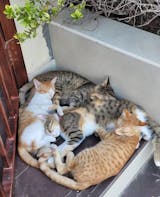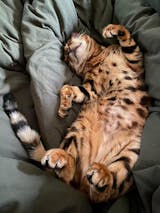Today marks International Homeless Animals' Day 2025 and Clear the Shelters Day—two events dedicated to raising awareness about the countless homeless pets waiting for a second chance. Whether you adopt a cat, volunteer at a local shelter, or simply spread the word, every action makes a difference in changing an animal’s life.
If you're in the U.S., you can find nearby shelters and adoption events through Petfinder's Shelter Search.
As the world’s first AutoComb for cats, we want to share helpful tips for anyone considering adopting a rescue kitten—especially first-time cat parents.
Choosing the Right Age for Adoption
While kittens can be adorable at any age, the ideal adoption window is between 2 to 6 months old. At around 8 weeks, kittens are weaned off milk and can eat solid food, eliminating the need for bottle-feeding. This age also means your kitten can already use the litter box independently—saving you the extra work of manual assistance.
Preparing Your Home for a New Kitten
Before bringing your kitten home:
-
Start Small — Settle your kitten in a small, quiet room to reduce stress.
-
Food & Litter Box Setup — Keep at least one litter box per cat and feed the same food the kitten was eating before. If you need to change the diet, mix the new food gradually over 7–10 days.
-
Enrichment & Play — Young kittens have high energy levels, so prepare cat toys, tunnels, scratchers, and climbing trees to keep them engaged and happy.
Socialization Training
Early socialization is key to raising a confident and well-adjusted cat. Start gently handling your kitten's paws to help them get used to nail trimming, and introduce regular brushing with a comb to prevent future grooming resistance. If you hope to have a cat that enjoys being held, gradually increase the time you hold them when they're calm—never release them immediately when they meow, as it can reinforce the habit.
Health Check: Vaccines & Common Early Illnesses
A vet appointment soon after adoption is essential—not only for a wellness check, but also to start your kitten's vaccination schedule.
Core Vaccines for Cats in the U.S.:
-
FVRCP Vaccine (Feline Viral Rhinotracheitis, Calicivirus, Panleukopenia)
-
Rabies Vaccine (required by law in most states)
-
FeLV Vaccine (Feline Leukemia Virus) — recommended for kittens with outdoor access or multi-cat households.
Typical Kitten Vaccine Timeline:
-
6–8 weeks old: First FVRCP shot.
-
Every 3–4 weeks thereafter: Booster shots until about 16 weeks old (3 rounds total).
-
12–16 weeks old: First rabies vaccine.
-
FeLV: Two doses, 3–4 weeks apart, starting as early as 8 weeks old if recommended by your vet.
Common Early Illnesses to Watch For:
-
Conjunctivitis: Redness, watery/yellow discharge, frequent blinking.
-
Upper respiratory infections: Sneezing, nasal discharge, watery eyes, lethargy.
-
Parasites: Fleas, ear mites, intestinal worms—common in rescue kittens and treatable with vet care.
Bring any available health records to your first vet visit so your veterinarian can create a personalized vaccination and parasite prevention plan.
A Loving Home Changes Everything
Every cat deserves safety, comfort, and love. By adopting, you’re not only saving a life—you’re also making space in the shelter for another animal in need.
If you’re welcoming a rescue cat into your home this year, consider making their new life even better with the AutoComb—a cozy cat bed and gentle self-grooming station in one. It helps your cat build a healthy, stress-free grooming habit through daily, painless brushing—while giving them a favorite spot to nap.
🐾 Join the movement this International Homeless Animals' Day and Clear the Shelters Day. Whether through adoption, volunteering, or donating, your kindness can transform a life forever.
🧠 Cat Fact: Cats Need Essential Vitamins—But Not from Vegetables
Cats are obligate carnivores, which means they must eat meat to survive—not just for protein, but also for essential nutrients like taurine, vitamin A, and arachidonic acid.
🥦 While vegetables might seem like a healthy source of vitamins, cats can’t properly digest or absorb nutrients from plants.
💡 Unlike humans, cats need many of their vitamins in a pre-formed, “ready-to-use” state—found naturally in animal tissue.
So yes, cats definitely need vitamins—just not from veggies.
That’s why high-quality cat food is specially formulated to meet their nutritional needs—no salad bar required.






